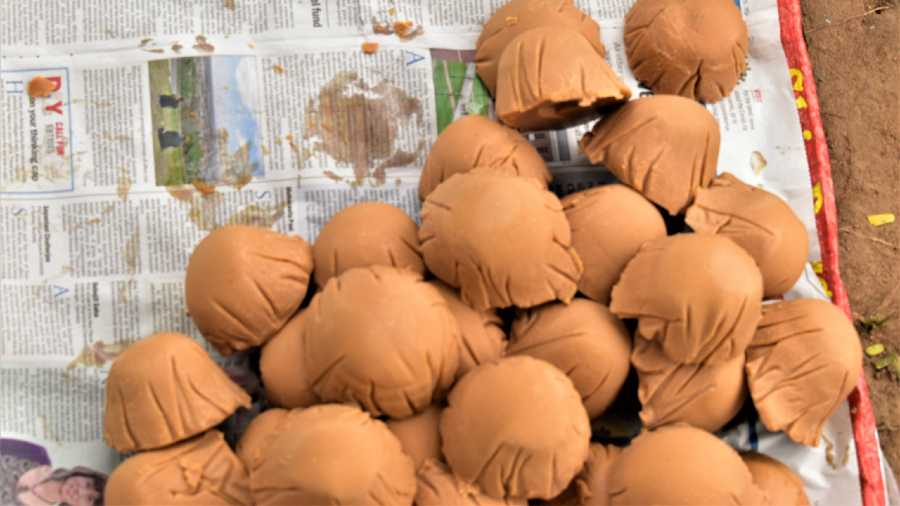Winter is a time of celebrations, of Christmas, of a new year and of a new harvest. In the eastern part of India, Sankranti — or Poush Sankranti, as it is known here — is celebrated with pithe, sweets made with powdered new rice, milk, coconut and jaggery. In Bengal, this is usually nolen gur or traditionally made — the term these days is artisanal — jaggery from the sap of date palms.
Nolen gur is the flavour of winter — the date palm produces sap only when temperatures go down to 14°Celsius. Yet people start expecting nolen gur delicacies with the first chill wind. “Customers start asking for nolen gur sweets from mid-November,” says Madhuri Modak, managing director of Jalbhara Surjya Kumar Modak in Chandernagore. The shop is named after their illustrious ancestor who invented the jolbhora talshash sandesh, the chicken a la Kiev of sweets that boasts of a nolen gur centre in winter.” But the first nolen gur is produced only after mid-December, she adds.
Quality sweets come from quality gur. But how does one recognise good gur? “It is a matter of experience. You just know if artificial flavour has been added,” says Modak, racking her brains to articulate the difference in words. “Good nolen gur will vanish in your mouth, there will be no aftertaste unlike sugar, which turns slightly tangy in your throat,” she finally says, while adding that they also measure gur density. Nolen gur adulterated with sugar is much more dense than the original thing.
The treacle-coloured but much runnier nolen gur is only one form of date palm jaggery, there is also patali gur — pale brown mounds of solidified sweetness. “Quality patali will crumble at the slightest pressure of fingers,” says Modak.

Freshly made patali gur Paromita Sen
Prajesh Nandy of Girish Chandra Dey and Nakur Chandra Nandy, the chain of shops known for their nolen gur sweets in winter, prefers nolen gur to patali gur. “You cannot make patali without adding sugar syrup to solidify the gur,” he says.
Obviously, sugar is an adulterant. It is, in fact, the most common adulterant in date palm jaggery, which retails from anything between Rs 150 to Rs 600 a kilo.
“Nearly all nolen gur available in the market has some sugar,” says Rabiul Islam of the non-government organisation SEVA Bikash Kendra of Aatghara, Hooghly. He is candid about the fact that the gur he is retailing at Rs 200 a kilo at his stall in the weekly haat in Dum Dum has “nothing harmful, only added sugar”. What would pure nolen gur cost? “Rs 500 a kilo and you will have to give me a week’s time. It will take that time to collect the sap needed,” he says.
Nolen gur makers add sugar to date palm sap for two reasons — to cut costs and because they cannot supply enough jaggery without it. Sugar is used because it is cheapest — Rs 40 a kilo to sugar cane jaggery’s Rs 120 a kilo. It helps that caramelised sugar’s flavour profile matches the smoky, earthy taste of nolen gur. Well, almost.
For that lovely smell of nolen gur, the makers — all nolen gur except for the tube variety is manufactured on a very small scale, say 10 kilos at a time — thicken the gur with sugar instead of boiling it for the requisite time.
“This gur spoils very fast,” says Sanat Adhikary, who has a savoury and sweet shop on Prantik Road in Bolpur. He adds a splash of this gur to intensify the aroma coming off his famed nolen gurer rosogolla. Artificial nolen gur flavouring, while available, is expensive and difficult to access, explains Adhikary.
Nandi says the best nolen gur of his memories used to come from Krishnagar in Nadia. Nadia produces the best quality nolen gur these days as well as a few areas in Basirhat, says Islam.
But Modak’s nolen gur comes from Agradeep in Burdwan, where she has tied up with gur makers to supply her a certain quantity and quality every year. “The quality is not as good as it was earlier because the trees don’t get the rest that they should have between tappings,” says Modak, while explaining that nolen gur does not solidify in the freezer.
Like Modak, many sweetshops stock nolen gurer sweets throughout the year.
Nandi points out that they are one of the few famous mishti shops to stock nolen gur sweets only in winter. He says, “Demand far outstrips supply of nolen gur. That is why we do not make nolen gur sweets throughout the year. It is a special gift of winter. Let us keep it so.”











